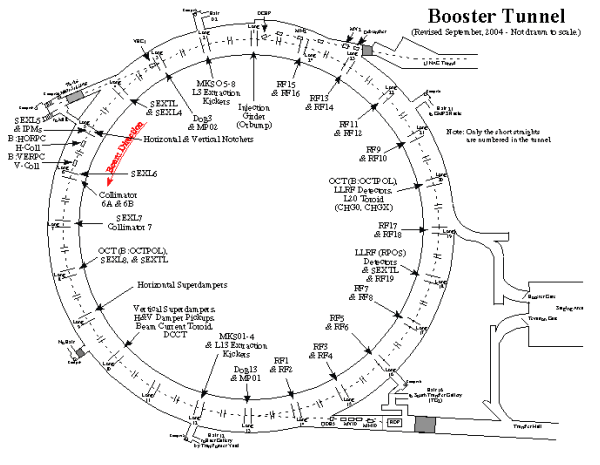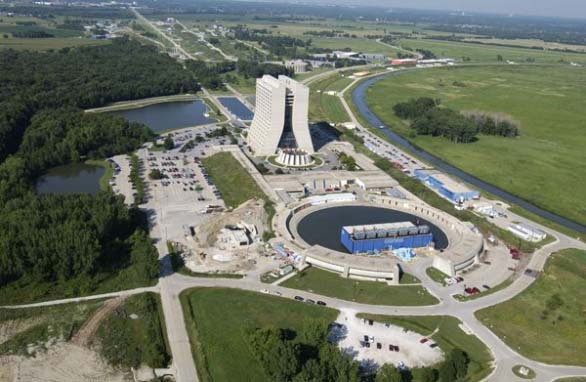|
The Booster is the third accelerator in the Fermi chain of accelerators. It takes 400 MeV H- ions from the Linac (through the 400 MeV transfer line), strips the electrons off, accelerates the remaining protons to 8 GeV, and then sends them on to the Main Injector.
Booster History
Most proton synchrotrons built before Fermilab used a linear accelerator to inject protons directly into their main accelerator. The Fermilab Main Ring design had a final energy larger than any existing accelerator. It would have required a linear accelerator four miles long to accelerate protons to the unprecedented injection energy of 8 GeV. At the time, cost and design problems made this impractical.
Designers decided that a "booster" accelerator would give an intermediate boost to the beam energy between the LINAC and the Main Ring. One of the main factors affecting the injection energy was the cost of the LINAC versus the cost of the Booster RF. The designers saw that a small reduction in beam quality was worth the large cost reduction, approximately $500,000.
The final design resulted in a circumference 13.25 times smaller than the Main Ring. (The Booster is 1/7 the size of the Main Injector.) To fill the Main Ring with beam, the Booster must go through repeated acceleration cycles, transferring each cycle's worth of beam. Each of the extracted beam pulses is referred to as a "batch." Only 12 of the possible 13 batches were injected into the Main Ring, since a gap had to be preserved in the beam to allow time for kickers to rise to their proper voltage.

Designers considered both slow and fast cycling boosters. The slow cycling machine would have had the advantage of being able to fill the Main Ring rather quickly. However, this would have required a multiple turn extraction from the Booster, which would have introduced other problems.
Injection and extraction systems were created, as well as the high and low level RF acceleration systems. The gradient magnets were designed with consideration to the power supply system and vacuum chamber requirements. Construction progressed quickly and beam was first injected into the Booster in October 1970. The Main Ring received extracted beam the following spring.
Over the years, the original 16 RF cavities were increased to 18, reduced to 17 when the Low Level RF room was expanded, and then increased back to 18. (As of fall of 2004, there will be 19 cavities.)
The Booster was typically operated well below its full capability during normal operations. This was due to the Main Ring aperture being only half the size of the Booster aperture. The LINAC upgrade, which took place in the summer of 1993, increased the energy of the LINAC beam from 200 MeV to 400 MeV. The upgrade also increased the Booster aperture at injection due to adiabatic damping within the new LINAC. The purpose of the upgrade was to produce larger antiproton stacks. Unfortunately, the Main Ring was not capable of accelerating the quantity of protons that the Linac and Booster could provide. Eventually, these aperture mismatches between the Booster, Main Ring, and the Antiproton Source became acute.
The Main Injector removed these mismatches, but that's another story.

Accelerator Update Archive
| 
